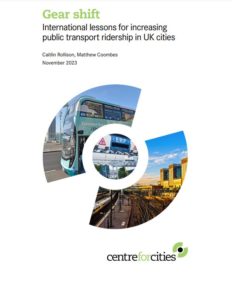Double bus commuters for European levels of public transport – report
A doubling of the number of commuters using buses is needed for UK cities to catch up with the numbers seen in Europe using public transport, according to a new report.
transport, according to a new report.
The ‘Gear shift: International lessons for increasing public transport ridership in UK cities’ study suggests the UK’s big cities outside of London are outliers and would need nearly one million (936,000) additional workers taking public transport to work to bridge the gap with other cities overseas. Comparing UK and overseas cities, 16% of Manchester residents and 18% of Birmingham residents commute to work using public transport, compared to 40% in Hamburg and 33% in Lyon, two European cities of similar size.
The report was published by the Centre for Cities, a think tank dedicated to improving the economies of the UK’s cities and towns, in partnership with Go-Ahead. Evidence shows there are fewer car journeys done in large European cities thanks to their greater reliance on public transport compared to the big cities in the UK.
Centre for Cities outlines several policy measures drawing evidence from London and cities overseas that have higher levels of public transport ridership:
- Develop the density of commercial property in city centres to increase the concentration of jobs in existing commercial locations.
- Improve residential density and the use of Local Development Orders to create new mid-rise developments near existing and new public transport stops.
- Bring responsibilities for running a city’s public transport services together under one body similar to TfL.
- Where existing commercial partnerships are not working, consider using new bus franchising powers created by recent and upcoming legislation in England and Scotland to improve the integration of services, including integrated ticketing and daily fare caps.
- Provide cities with transport-related revenue-raising powers such as congestion charging or workplace parking levies that provide cross-subsidies to fund investment in transport networks and make journeys by public transport more beneficial relative to journeys by car.
£2 fare unlikely to affect long-term change
It notes that short-term measures such as the £2 bus fare cap do not improve the financial sustainability or performance of bus services over time and are unlikely to bring about long-term change in passenger behaviour.
“What these policy recommendations are aiming for is finding that extra gear so we can bring more people into our city centres during working hours, quicker and, preferably, cheaper too” – Andrew Carter, Chief Executive at Centre for Cities
Andrew Carter, Chief Executive at Centre for Cities, said: “What these policy recommendations are aiming for is finding that extra gear so we can bring more people into our city centres during working hours, quicker and, preferably, cheaper too. In order to get there and find that extra gear, we need to look at different policy measures from around the world, look at how they are funded, look at where we can bring in extra revenues, and do that in ways that also help us invest in our public transport networks for the long term.
“What you see in other big cities around the world is more people take public transport and the network is serving its purpose in the regional economy: large cities can use their space more efficiently and a greater number of workers can reach the city-centre to access opportunities there. Transport has huge implications for the UK’s route to achieving net zero carbon emissions, too.”
“Easy to navigate transport hubs, bus priority measures and better planning around stations can make a big difference, as the Centre for Cities’ report points out” – Miguel Parras, Group Chief Executive of Go-Ahead
Miguel Parras, Group Chief Executive of Go-Ahead, said: “It’s vital that modern, dynamic cities encourage more people onto public transport if they’re to tackle congestion and pollution. Easy to navigate transport hubs, bus priority measures and better planning around stations can make a big difference, as the Centre for Cities’ report points out.
“Any successful public transport system needs to blend clear thinking from a central transport authority with the entrepreneurial flair of private operators – whether that’s on bus, rail or light rail. In some cities, that can mean franchising, while in others it might simply mean a close, co-operative partnership between public and private, working towards a common goal.”